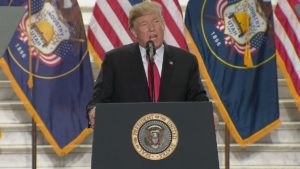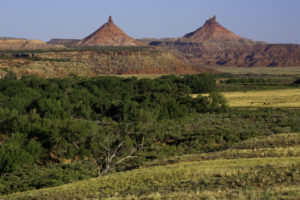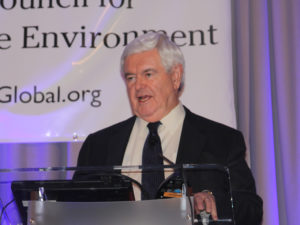Dec
11
Is Trump’s Action on National Monuments Really Unprecedented, Disgraceful, and Illegal?
“The little guys’ voices were heard. Voices in the community were heard. This administration has the strength and the will to be there for us. This is a great day for Utah.” — state Rep. Gregory H. Hughes, the speaker of the Utah House of Representatives
Earlier this week and at the recommendation of Secretary of the Interior Ryan Zinke, President Trump announced that he was signing two presidential proclamations that would reduce the sizes of the Bears Ears National Monument and Grand Staircase-Escalante National Monument in Utah. Based on the invective by some (mostly on the Left), one would think this move was historically unprecedented (as if that’s necessarily bad), a “disgrace” and an “ugly violation of stewardship responsibility”, a vandalization of “our wild heritage”, an “assault on our humanity”, and probably illegal. One retail company is even launching a PR campaign and suing the President, and they aren’t the only ones taking legal action. But, then, most of these are environmentalists and Trump-haters who could find some way to vilify him even if he saved a box of puppies out of a fire.
“We need more [national parks], not less. This government is evil and I’m not going to sit back and let evil win.” — Yvon Chouinard, environmental activist, founder and CEO of outdoor gear maker Patagonia
Before deciding to issue the proclamations, Trump consulted with friends in Utah (including U.S. Senators Hatch and Lee and local legislators) on the matter:
“They said this would be incredible for our country, will be incredible for Utah. Finally, you’d be giving people back their access to the land they know, to the land they understand, and most importantly to the land that they love….
As many of you know, past administrations have severely abused the purpose, spirit, and intent of a century-old law known as the Antiquities Act. This law requires that only the smallest necessary area be set aside for special protection as national monuments. Unfortunately, previous administrations have ignored the standard and used the law to lock up hundreds of millions of acres of land and water under strict government control. These abuses of the Antiquities Act give enormous power to far-away bureaucrats at the expense of people who actually live here, work here, and make this place their home….
Public lands will once again be for public use. Families and communities of Utah know and love this land the best, and you know the best how to take care of your land and how to conserve this land for many generations to come.”
As per CNN’s Bill Weir,
“Locals in the area saw the designations as nothing more than a 3-million-acre federal land grab. The drillers, miners and frackers who were shut out by Clinton’s and Obama’s use of the Antiquities Act would have new leases on life. Sen. Orrin Hatch and his fellow Utah Republicans would have a major victory to celebrate.
But those who believe the rocks can talk, through countless fossils, sacred ruins and desert solitude, are bracing for a fight.”
As part of an agenda to rein in executive overreach, this move by the administration is essentially a partial annulment or repeal of certain federal land protections initiated under Presidents Clinton and Obama. Bears Ears will be reduced by over 80% (from 1.35 million acres to over 228,000 acres) and divided into two sections, whereas Grand Staircase-Escalante will shrink roughly 45% (from 1.87 million acres to just over 1 million acres) and be split into three sections. Thus, it frees up about 2 million acres, returning control to the citizens of Utah.
If you don’t mind, I’d like to address the titular questions out of order….
Illegal?
Most of the legal complaint I have seen is the claim that, while the 1906 Antiquities Act gives the President the right to declare a national monument by proclamation, it does not grant him the right to unilaterally remove such protection status from an existing monument. Only Congress can do that. This may be true. However, consider the following caution to FDR written by his Attorney General, Homer Cummings, in 1938 (Time, citing a 2016 Congressional Research Service report):
“The statute does not in terms authorize the President to abolish national monuments, and no other statute containing such authority has been suggested. If the President has such authority, therefore, it exists by implication…. While the President from time to time has diminished the area of national monuments established under the Antiquities Act by removing or excluding lands therefrom, under that part of the act which provides that the limits of the monuments “in all cases shall be confined to the smallest area compatible with the proper care and management of the objects to be protected,” it does not follow from his power so to confine that area that he has the power to abolish a monument entirely.”
There is some debate about whether or not Cummings’ recommendation against abolishment of a national monument via presidential proclamation is legitimate or fully binding. But, since Trump is shrinking the sizes of the two monuments and not trying to get rid of them, it would seem that the law is on his side. At least, as far as this primary complaint goes, though some are claiming the President has no authority to reduce their size, either.
This brings me to the matter of Trump’s action being unusual or unprecedented. Notice that Cummings mentions matter-of-factly that “the President from time to time has diminished the area of national monuments established under the Antiquities Act by removing or excluding lands therefrom”. It is unclear to me if he is referring to FDR in particular or to the office of the President in general. (Though, only 6 preceded FDR since the Antiquities Act was passed under his fifth cousin, Teddy Roosevelt.) Regardless, that meant there had already been precedent prior to 1938, and there have been many since. Newt Gingrich points out,
“Similar actions have been taken at various federal monument sites nearly 20 times before by presidents such as John F. Kennedy, Woodrow Wilson, and Dwight D. Eisenhower.”
Where it might be legitimate to claim lack of precedence is in the total number of acres relinquished by the federal government from Trump’s proclamations. That sounds like a good record to set, to me.
Two million acres is a lot, especially considering that the combined land “seized” by Clinton and Obama for these two national monuments was roughly 3.37 million acres. Utah is getting nearly 60% back. Of course, even this seems small when you look at the total numbers. From The Daily Signal (with my added notes):
“[T]he Obama administration set aside 554 million acres and the George W. Bush administration set aside another 215 million acres. [Note: Yes, Bush declared some monuments which are of questionable wisdom and legality.] Before that, only 71 million acres were set aside by all previous presidents combined. [Note: This would have included the 1.87 million acres appropriated by Clinton for the Grand Staircase-Escalante National Monument.]”
Disgraceful?
As for the third type of accusation (e.g., “disgraceful”, “degrading”, “vandaliz[ation]”, etc.), it’s mostly fearmongering rhetoric, imo — especially by those who claim Trump is on a warpath to shut down all natural monuments in a massive land-grab effort, so that they can be ruthlessly exploited. On the contrary, his April 26 executive order to review national monument designations under the law since 1996 is an effort to return federally-seized lands to state control (even if still managed by federal agencies). As summarized by the Daily Caller:
“The Interior Department will focus on “righting past overreach,” according to an official, by protecting national monuments in a manner that’s “consistent with the law.” The agency will also ensure lands [are] properly cared for, and that critical infrastructure, like roads, bridges and trails, don’t fall into disrepair….
The agency’s plan for national monuments will focus on six priorities: preserving traditional uses, public access, infrastructure, local consultation, tribal rights and protecting hunting and fishing rights.”
Fortune‘s Joseph Hincks writes,
“Native American and environmental protection groups fear removing federal protections paves the way for environmentally destructive corporate activities on land of archaeological significance.”
Former county commissioner and Navajo elder Mark Maryboy cites past desecrations of sacred ruins, as well as demonstrating a healthy skepticism that his fellow Native Americans will benefit from any new jobs.
“The experience that Native Americans see in this county is discrimination. They are the last ones to be hired for any position. Even if there’s a huge mining operation opening up, they will not be hired for that position. And they will be exposed to the toxic materials that are left on the ground or in the air.”
Now, I can understand their concerns to a degree, and there may even be some basis for them. There is, after all, a huge economic advantage to “freeing up” these lands. It opens up the potential for more and better access to in-demand natural resources — namely, over 60 billion tons of coal reserves in the Grand Staircase-Escalante area and uranium, oil, and natural gas reserves around Bears Ears. This will mean jobs and money for the local economy (also resulting in tax revenue for the government, of course), which is in a very poor region of Utah. I think Maryboy’s concerns need to be addressed, though. Also, to be fair, one has to wonder what the impact may be on those who depend on spending from tourists. Overall, will it be better? Worse? Or balance out? Is tourism truly better for the land than the alternatives?
According to CNN’s article, San Juan County Commissioner Phil Lyman “argues that oil and gas extraction would have less impact on the landscape than the brand of adventure tourism that has transformed nearby Moab. ‘By designating a monument, you are using a tool that will bring hordes of people to a place that is very sensitive,’ he says.”
It’s worth noting that it is primarily outside groups that are raising all the ruckus. Back when the Bears End designation was still merely a proposal, it was the (non-local) Bears Ears Inter-Tribal Coalition and various environmental activist groups that supported and campaigned for Obama’s plan to declare Bears Ears a national monument. The local Native Americans — along with the San Juan County Commission; Utah Gov. Gary Herbert (R); the GOP-controlled state legislature; and Utah’s representatives in Congress — were largely opposed to it. According to a UtahPolicy.com poll conducted in May 2016 by Dan Jones and Associates, only 17% of respondents wanted Obama to declare Bears Ears a national monument. Thirty-one percent were in favor of a bill by Representative Rob Bishop that would make Bears Ears a national conservation area, with some protections and local land control, and would also allow energy development in certain areas. Another 36% thought Bears Ears should’ve been left alone.
“Whereas supporters of a monument see it as a way to best protect Bears Ears from looting, mining, and drilling — and a tourist boon for the area’s struggling economy — local Native Americans who oppose it don’t trust the federal government to look out for their interests.” — Josh Siegel, The Daily Signal
From what I understand, it was a similar situation back in 1996, when Clinton wanted to designate the Grand Staircase-Escalante lands a national monument. Seems to me that the people of the region in question should be able to decide what the land is used for, by whom, and the best way to preserve sacred sites and cultural heritage. There’s nothing disgraceful or degrading about that.
Benjamin Arie from Conservative Tribune makes the following observation regarding Bears Ears National Monument:
“Isn’t it interesting that the left seemed completely fine with the exact same area of land not being a national monument during seven and a half years of Obama’s presidency? It was only designated as such in the final six months of Obama’s tenure, but suddenly Trump is an anti-environmental monster for putting it back to how it was before?”
Former House Speaker Newt Gingrich gives his informed reading of the situation, as well:
“[As a life-long conservationist], allow me to set something straight: Despite what the Administration’s critics might say, redefining the boundaries of these monuments will not harm the environment, open the flood gates for dangerous mining or natural resource exploitation, or endanger Native American artifacts or historic locations.
The land around the monuments will continue to be federally protected and managed by one of our several highly-qualified federal land management agencies – which are the same agencies that manage national monuments. These surrounding public lands will be reclassified and will become national forests, wilderness areas, or other federally-controlled, cherished natural sites.
Here’s the difference: The regulatory regime for a national monument is focused entirely around protecting specific objects, so federal regulators have more control over what activities can and cannot happen on the designated land…. This reclassification may change which federal agency manages a particular portion of the surrounding land…. What the changes mean is that the people of Utah will have increased access to the land for grazing cattle, hunting, fishing, harvesting timber, and other traditional uses.”
I noticed Gingrich left mining out of his list at the end, and he earlier dismissed the idea that the re-sizing would “open the flood gates for dangerous mining or natural resource exploitation”. I’m not sure if this means there would still be restrictions against mining or merely that he believes any mining would be limited and responsibly managed.
In the end, it seems that the alarmist cries by some (non-local) groups are mostly, if not completely, unfounded. As President Trump expressed, it is the people who live and work in the region who know it best and should be the ones to determine how best to both exploit (in the positive sense) and conserve it.




















